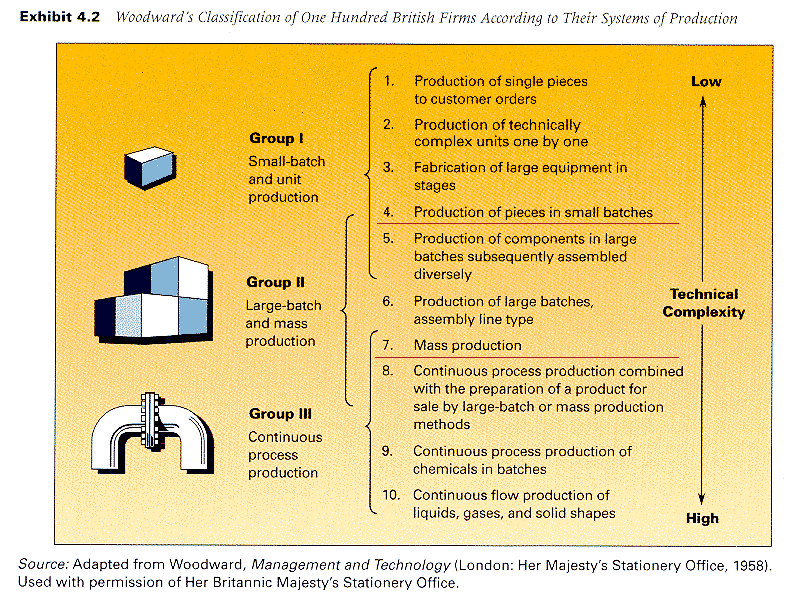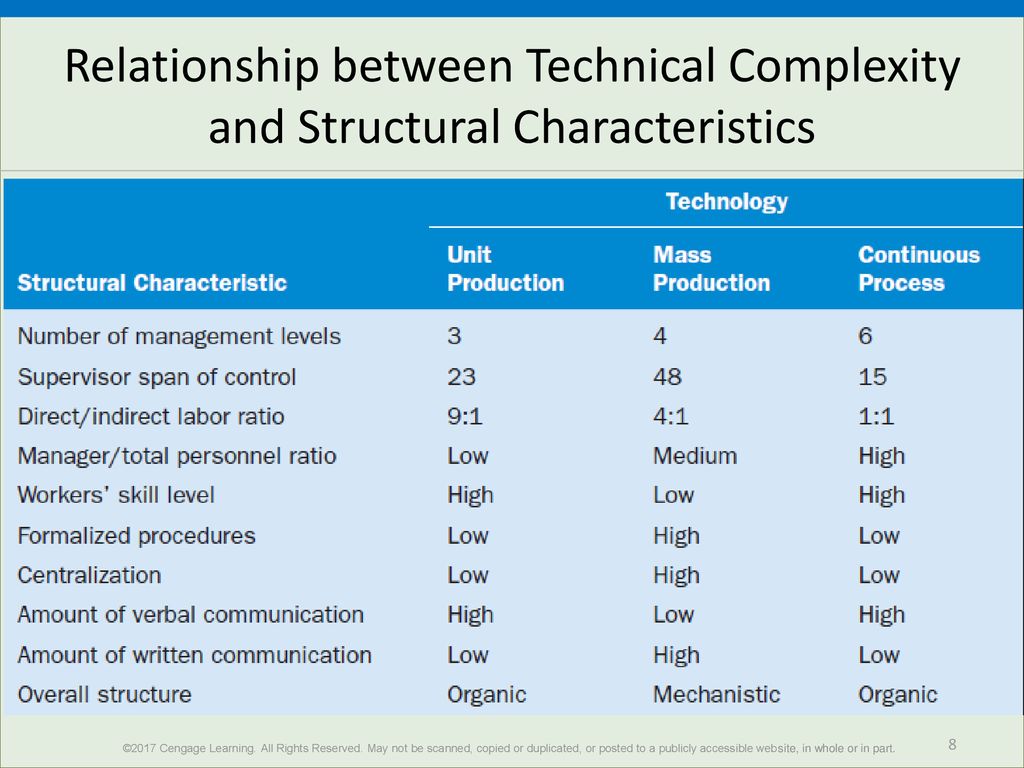Core Organization Technology
Core Organization Technology for Manufacturing Firms
Manufacturing technologies include traditional manufacturing processes and contemporary applications, such as the smart factory and learn manufacturing.
The first and most influential study of manufacturing technology was conducted by Joan Woodward, a British industrial sociologist. Her research began as a field study of management principles in south Essex.
The prevailing management wisdom at the time (1950s) was contained in what were known as universal principles of management. These principles were “one best way” prescriptions that effective organizations were expected to adopt. Woodward surveyed 100 manufacturing firms firsthand to learn how they were organized. She and her research team visited each firm, interviewed managers, examined company records, and observed the manufacturing operations. Her data included a wide range of structural characteristics (e.g., span of control, levels of management), dimensions of management style (e.g., written versus verbal communications, use of rewards), and the type of manufacturing process. She also collected data that reflected the commercial success of the firms.
Woodward developed a scale and organized the firms according to the technical complexity of the manufacturing process.
Technical complexity represents the extent of mechanization of the manufacturing process.
- High technical complexity means most of the work is performed by machines.
- Low technical complexity means workers play a larger role in the production process.
Woodward’s scale of technical complexity originally had 10 categories, as summarized in Figure X-1.
 Figure X-1 Woodward’s Classification of 100 British Firms According to Their Systems of Production Credit — Slideplayer Opens in new window
Figure X-1 Woodward’s Classification of 100 British Firms According to Their Systems of Production Credit — Slideplayer Opens in new window
These categories were further consolidated into three basic technology groups, as follows:
- Group I: Small-Batch and Unit Production
These firms tend to be job shop operations that manufacture and assemble small orders to meet specific needs of customers. Custom work is the norm.
Small-batch production relies heavily on the human operator; it is thus not highly mechanized.
One example of small-batch production is Hermes International’s Kelly handbag, named for the late actress Grace Kelly. Craftsmen stitch the majority of each $7,000 bag by hand and sign it when they finish. A traditional distribution center at Amazon might also be considered a small-batch service operation. Workers pick products off shelves and assemble orders one at a time for customers.
- Group II: Large-Batch and Mass Production
Large-batch production is a manufacturing process characterized by long production runs of standardized parts. Output often goes into inventory from which orders are filled because customers do not have special needs. Examples include traditional assembly lines, such as for automobiles.
- Group III: Continuous-Process Production
In continuous-process production, the entire process is mechanized. There is no starting and stopping. This represents mechanization and standardization one step beyond those in an assembly line.
Automated machines control the continuous process, and outcomes are highly predictable. Amazon’s new fully automated distribution centers could be considered continuous-process production. Amazon recently bought Kiva Systems, which provides robots that bring all the items needed for a customer’s order to a worker. Other robots then take the filled boxes to the shipping door. Other examples would include chemical plants, oil refineries, liquor producers, pharmaceuticals, and nuclear power plants. Royal Dutch Shell’s new “Pearl GTL” (gas-to-liquid) plant in Qatar provides an illustration. At the new processing facility, natural gas flows through a maze of pipes, storage tanks, gasification units, distillers, reactors, and other equipment, while highly skilled employees monitor operations from a central control room. GTL uses chemical processes to physically change the composition of gas molecules to produce a colorless, odorless fuel similar to diesel but without diesel’s pollutants.
Using this classification of technology, Woodward’s data made sense. A few of her key findings are given in Figure X-2.
 Figure X-2 Relationship between Technical Complexity and Structural Characteristics | Credit — Slideplayer Opens in new window
Figure X-2 Relationship between Technical Complexity and Structural Characteristics | Credit — Slideplayer Opens in new window
The number of management levels and the manager-to-total personnel ratio, for example, show definite increases as technical complexity increases from unit production to continuous process. This indicates that greater management intensity is needed to manage complexity because more indirect workers are required to support and maintain complex machinery. Other characteristics, such as span of control, formalized procedures, and centralization, are high for mass-production technology because the work is standardized, but low for other technologies. Unit (small-batch) production and continuous-process technologies require highly skilled workers to run the machines and verbal communication to adapt to changing conditions. Mass production is standardized and routinized, so few excpetions occur, little verbal communication is needed, and employees are less skilled.
Overall, structure and management systems in both unit production and continuous-process technology are characterized as organic. They are more free-flowing and adaptive, with fewer formal procedures and less standardization. Mass production, however, is mechanistic, with standardized jobs and formalized procedures. Woodward’s discovery about technology thus provided substantial new insight into the causes of organization structure. In Joan Woodward’s own words, “Different technologies impose different kinds of demands on individuals and organizations, and those demands had to be met through an appropriate structure.”
An organization’s core technology is the work process that is directly related to the organization’s mission, such as teaching in a high school, medical services in a health clinic, or manufacturing at American Axle & Manufacturing (AAM) Opens in new window.
AT AAM, Opens in new window the core technology AAM, the core technology begins with raw materials (e.g., steel, aluminum, and composite metals).
Employees take action on the raw material to make a change in it (e.g., they cut and forge metals and assemble parts), thus transforming the raw materials into the output of the organization (e.g., axles, drive shafts, crankshafts, and transmission parts).
For a service organization like UPS, the core technology includes the production equipment (e.g., sorting machines, package handling equipment, trucks, and airplanes) and procedures for delivering packages and overnight mail. In addition, as at companies like UPS and AAM, computers and digital information technology have revolutionized work processes in both manufacturing and service organizations.
Figure X-1 features an example of core technology for a manufacturing plant. Note how the core technology consists of raw material inputs, a transformation work process (e.g., milling, inspection, assembly) that changes and adds value to the raw material and produces the ultimate product or service output that is sold to consumers in the environment.
In today’s large, complex organizations, core work processes vary widely and sometimes can be hard to pinpoint.
A core technology can be partly understood by examining the raw materials flowing into the organization, the variability of work activities, the degree to which the production process is mechanized, the extent to which one task depends on another in the workflow, or the number of new product or service outputs.
Organizations Opens in new window are also made up of many departments, each of which may use a different work process (technology) to provide a good or service within the organization.
A noncore technology is a department work process that is important to the organization but is not directly related to its primary mission.
Thus, R&D transforms ideas into new products, and marketing transforms inventory into sales, each using a somewhat different work process. The output of the HR department is people to work in the organization, and accounting produces accurate statements about the organization’s financial condition.
You Might Also Like:
- Research data for this work have been adapted from the manual:
- Organization Theory and Design By Richard L. Daft

